Essential maintenance for motorized adaptive sports gear requires daily diagnostic checks of batteries, wiring, and control systems. Clean surfaces with mild soap and disinfect properly. Charge batteries after each use and inspect for corrosion. Watch for warning signs like unusual noises or erratic movements. Store equipment in dry, cool environments and lubricate moving parts regularly. Proper maintenance extends your gear’s lifespan and prevents costly repairs down the road.
Daily Diagnostic Checks for Long-Term Gear Reliability
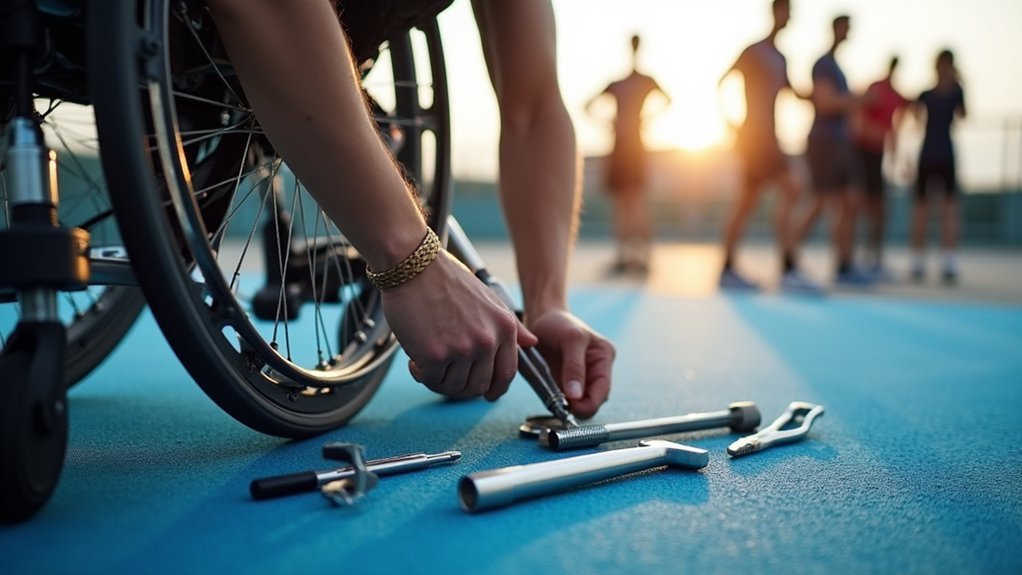
While many adaptive sports enthusiasts focus on the thrill of participation, your motorized equipment’s longevity depends on consistent daily diagnostics.
Start by checking your battery’s power levels to guarantee consistent performance during activities.
Battery health monitoring is your first line of defense against unexpected performance failures during critical moments.
Don’t overlook wiring and connections—inspect them for any signs of wear or loosening that could cause unexpected malfunctions.
Test your control systems daily to confirm they’re responding promptly and accurately to your commands.
Examine all moving parts for excessive wear, which can prevent smooth operation when you need it most.
Finally, keep your system’s software updated to maintain peak functionality and security.
These five-minute checks will dramatically extend your equipment’s lifespan and reliability, preventing frustrating breakdowns that interrupt your sporting experience.
Proper Cleaning Techniques for Motorized Components
Because dirt and moisture can considerably damage sensitive motorized components, establishing a proper cleaning routine is essential for your adaptive sports equipment. Start by using mild soap and water to remove debris from surfaces, focusing on high-touch areas like handles and controls.
For effective disinfection, apply EPA-approved products like MadaCide or Virex, following manufacturer instructions. Remember to keep electronic components dry to prevent damage.
| Component Type | Cleaning Method | Frequency |
|---|---|---|
| Metal frames | Disinfect and dry thoroughly | After each use |
| Rubber tires | Soap and water scrub | Weekly |
| Upholstery | Gentle cleaning products | Monthly |
| Electronic parts | Dry wiping only | After each use |
Always clean in well-ventilated areas and use non-latex gloves to protect your hands from cleaning chemicals.
Battery Care and Charging Best Practices
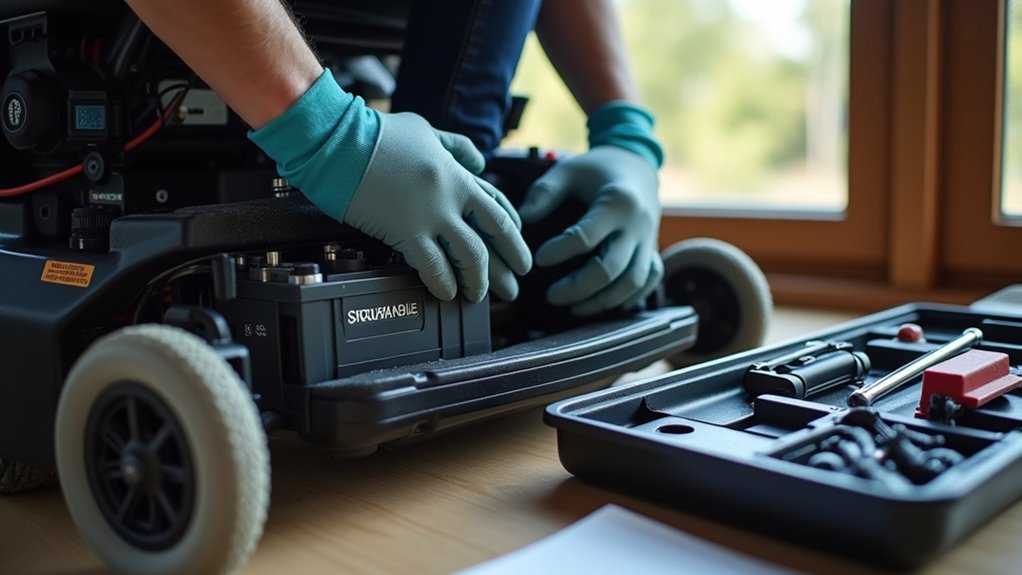
Since batteries power virtually all motorized adaptive sports equipment, proper maintenance directly impacts both performance and longevity.
Charge your batteries after each use, avoiding both deep discharge (below 20% for SLA batteries) and overcharging. Always use the original charger in well-ventilated areas.
Store batteries in cool, dry places between 50°F-77°F, away from moisture and extreme temperatures. For long-term storage, keep lithium-ion batteries at 40% charge and never completely discharge SLA batteries.
Choose the right battery type for your needs—SLA batteries are common but lithium-ion offers better performance and longevity.
Maintain smooth usage patterns, avoid rough terrain when possible, and regularly inspect connections for corrosion. These practices will greatly extend your equipment’s runtime and overall lifespan.
Preventative Maintenance Schedule Planning
Beyond battery management, developing a thorough preventative maintenance schedule stands as the foundation for keeping your motorized adaptive equipment in peak condition.
Don’t rely solely on time intervals—create a usage-based schedule that reflects how frequently you’re using your gear and under what conditions.
Incorporate pre-use checks into your routine to catch small issues before they become major problems. Track component lifespans and schedule replacements before failure occurs. Maintain detailed records of all maintenance activities to identify patterns and anticipate future needs.
Follow manufacturer guidelines for maintenance frequency, but adjust based on your environmental conditions—extreme temperatures, moisture, or terrain will necessitate more frequent attention.
Use digital calendars or reminder apps to guarantee you never miss critical maintenance tasks, especially for safety-critical components like brakes and steering mechanisms.
Recognizing Warning Signs of Equipment Failure
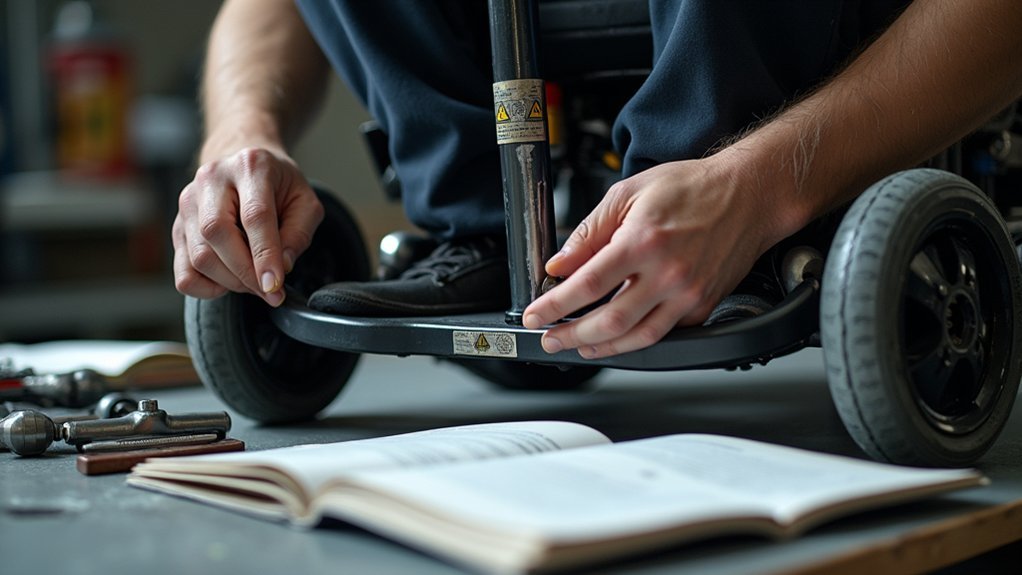
You’ll notice distinct warning signs when your adaptive gear’s motors begin to fail, including erratic movements, unusual noises, or greatly reduced speed during operation.
Damaged components often reveal themselves through visible cracks in the frame, misalignment of parts, or strange sounds when the equipment is in motion.
These early indicators shouldn’t be ignored, as addressing them promptly can prevent catastrophic equipment failure during your sporting activities.
Warning Signs for Motors
While maintaining your adaptive sports equipment, recognizing early warning signs of motor problems can prevent complete breakdowns and costly repairs.
Pay attention to unusual noises like grinding or rattling, as well as excessive vibrations during operation.
Overheating motors, reduced performance, or intermittent operation indicate potential issues that need immediate attention.
Watch for equipment that’s slow to start, stalls frequently, or runs roughly. Unusual odors, particularly burning smells, often signal dangerous electrical problems.
Be alert for rapid battery drain, which may indicate charging circuit issues.
Inspect wires regularly for damage or fraying that could cause malfunctions.
Regular monitoring through routine checks will help you identify these warning signs early.
Remember that proper storage in dry environments and standard cleaning practices can greatly extend your motor’s lifespan.
Damaged Component Indicators
Recognizing damaged components early can save you from dangerous equipment failures during adaptive sports activities. Perform regular visual inspections, looking for cracks, deformation, or unusual wear patterns on your equipment.
Pay attention to overload indicators like deployed energy absorbers or pop-stitch impact markers—these signal your gear has endured excessive stress.
Examine stitch patterns closely; damaged stitching often indicates extreme abrasion or loading that compromises structural integrity.
Don’t overlook cables and electrical components. Check for breaks in cable insulation, secure connector fittings, and straight, clean contact pins.
Heat signatures or glazing on ropes and other surfaces can reveal excessive friction points that may lead to failure.
These early warning signs allow you to address issues before they result in equipment malfunction during critical moments.
Safety System Verification and Testing
To guarantee the safety of motorized adaptive sports gear, thorough verification and testing are essential components of maintenance procedures.
You’ll need to check compliance with RESNA standards, which confirm your equipment meets rigorous safety protocols.
When verifying safety systems, focus on both mechanical resistance and environmental testing. Examine your gear’s structural integrity, looking for signs of material fatigue that might compromise performance.
You should conduct scenario-based testing that mimics real-world conditions you’ll encounter during sports activities.
Consider partnering with specialized testing facilities if you’re uncertain about proper verification procedures. Their advanced equipment can identify issues you might miss.
Remember that safety verification isn’t just about immediate concerns—it’s about confirming your adaptive sports equipment will protect you consistently over time through changing conditions and demanding use.
Seasonal Maintenance Considerations for Outdoor Sports
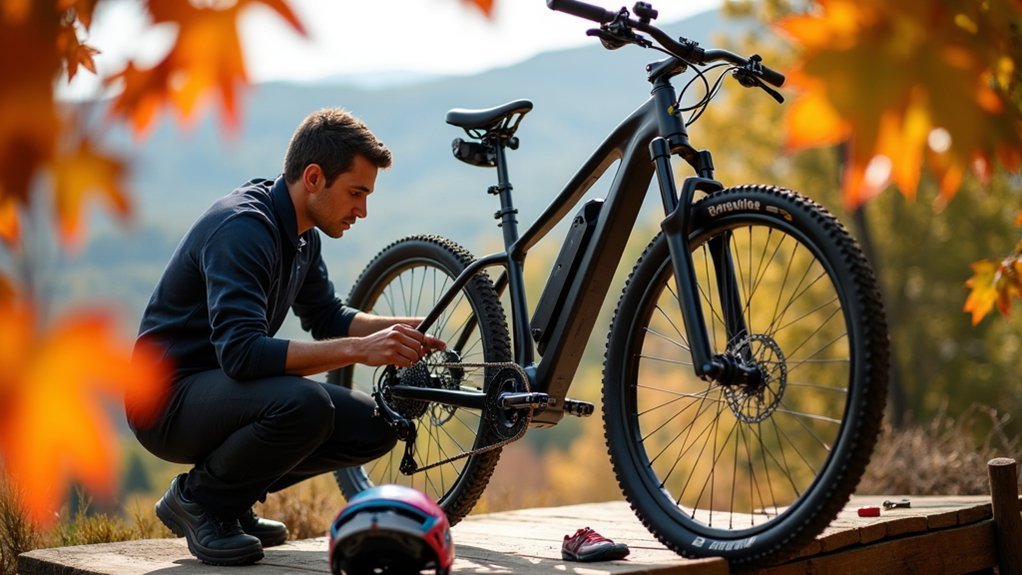
Seasonal changes present unique challenges for maintaining motorized adaptive sports equipment that go beyond standard safety protocols.
You’ll need to adjust your maintenance routine as weather patterns shift throughout the year.
For winter storage, verify your equipment is thoroughly cleaned, lubricated, and stored in a cool, dry place to prevent moisture damage.
When shifting between seasons, check tire pressures on e-bikes, inflate paddleboards to recommended levels, and charge batteries to appropriate storage levels.
Create season-specific checklists that account for your local climate conditions.
In humid environments, increase cleaning frequency, while coastal locations may require additional corrosion protection.
Apply climate-resistant coatings to exposed components and consider specialized storage methods for extreme temperatures.
Regularly consult with professionals about adaptive technology maintenance unique to your equipment.
DIY Repairs vs. Professional Service: When to Seek Help
When should you attempt DIY repairs on your motorized adaptive sports equipment, and when is it time to call in the professionals?
DIY repairs can save you money, reduce downtime, and empower you to better understand your gear. For minor issues like loose parts or basic battery problems, your toolkit with screwdrivers and Allen wrenches is often sufficient.
However, certain situations demand professional expertise:
- Complex electrical malfunctions that could compromise system integrity
- Severe physical damage to frames or critical mechanical components
- Repairs that might affect safety features or void your warranty
Essential Tools for At-Home Adaptive Gear Maintenance
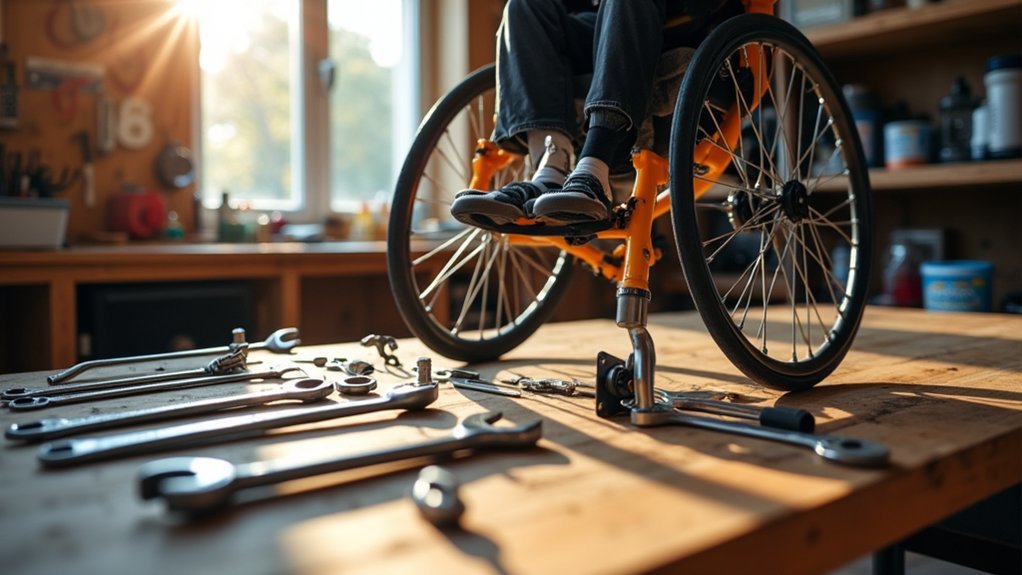
You’ll need a well-stocked tool kit with lubricants, multi-tools, and safety gloves to perform basic maintenance on your adaptive gear at home.
Specialty cleaning equipment like pressurized cleaning devices and soft cloths will help maintain peak performance and extend equipment lifespan.
Having the right tools readily available means you can quickly address minor issues before they become major problems requiring professional intervention.
Tool Kit Essentials
Maintaining adaptive sports equipment requires five categories of essential tools to guarantee your gear stays in peak condition. Your toolkit should include hand tools like pliers, screwdrivers, and socket sets for mechanical adjustments.
Additionally, include diagnostic tools such as multimeters and pressure gauges to identify issues before they worsen.
Never compromise on safety equipment while working on your gear:
- Work gloves to protect against cuts and abrasions
- Safety glasses to shield eyes from debris and chemicals
- First aid kit for immediate treatment of minor injuries
Keep maintenance guides handy for reference and organize everything in toolboxes with clear labeling.
You’ll work more efficiently with a well-organized system that lets you find exactly what you need when you need it.
Specialty Cleaning Equipment
Proper cleaning tools complement your basic maintenance kit and greatly extend the life of your adaptive sports equipment. For motorized gear, invest in EPA-approved disinfectants and antimicrobial treatments to protect frequently touched surfaces.
Keep soft brushes and microfiber cloths handy for cleaning intricate parts without causing damage. Long-handled dusters help you reach difficult areas of motorized equipment.
When dealing with leather components, apply conditioner after cleaning to prevent dryness.
Don’t forget personal protection—nitrile gloves and face masks shield you from cleaning chemicals and fumes. Organize your supplies in a dedicated cleaning station or caddy to guarantee everything’s accessible when needed.
Always follow manufacturers’ guidelines for cleaning procedures, and involve users in the maintenance process to build independence and equipment familiarity.
Extending Equipment Lifespan Through Proper Storage
While many adaptive sports enthusiasts focus on performance upgrades, effective storage practices represent one of the most overlooked aspects of equipment longevity.
Storing your gear in dry, cool environments protects against moisture damage and temperature fluctuations that can degrade components over time. Don’t forget to clean thoroughly before storage—dirt left on equipment can cause corrosion.
Proper storage in cool, dry places prevents costly damage and extends your adaptive equipment’s useful life.
For maximum protection, consider these essential practices:
- Apply appropriate lubrication to moving parts to prevent seizing and guarantee smooth operation when you’re ready to use the equipment again.
- Implement a detailed labeling system for quick identification, especially if you’re storing multiple pieces.
- Schedule regular inspections of stored equipment to catch potential issues before they become major problems.
Technology Updates and Software Maintenance
As adaptive sports equipment becomes increasingly sophisticated, software maintenance emerges as critical to achieving peak performance and safety. You’ll need to regularly update your gear’s software to access improved performance tracking, customization tools, and injury prevention algorithms.
Don’t overlook the importance of data management—connect your gear to cloud-based storage for seamless access to your performance metrics across devices. Most modern equipment includes sensors that provide real-time feedback; verify these are properly calibrated and connected to your analysis platforms.
Set up automated notifications for predictive maintenance alerts to prevent unexpected equipment failures. Remember that software updates often enhance user interfaces and accessibility features, making your gear more intuitive and responsive to your specific needs.
Following update schedules extends equipment lifespan while optimizing your athletic performance.
Community Resources for Maintenance Support
Finding reliable maintenance support doesn’t need to be a solo endeavor when you’re part of the adaptive sports community. Organizations like Move United and Challenged Athletes Foundation offer specialized resources, including maintenance grants and expert advice for your motorized equipment.
Local community centers often provide accessible spaces where you can work on your gear with others who understand your specific needs.
Look for these valuable resources:
- Adaptive sports organizations – Connect with groups like Oregon Adaptive Sports or Northeast Passage to find maintenance workshops in your area.
- Funding assistance – Apply for maintenance grants through Challenged Athletes Foundation or Move United Athlete Grants.
- Equipment-specific communities – Join specialized groups based on your sport for tailored maintenance advice and local repair recommendations.
Cost-Effective Maintenance Strategies and Funding Options
Maintaining motorized adaptive sports equipment doesn’t have to drain your bank account when you employ strategic approaches.
Implement regular inspections to catch issues early, potentially saving thousands in major repairs. Schedule maintenance to extend gear lifespan and train yourself on basic repairs to handle minor issues independently.
Consider leveraging community resources through partnerships with manufacturers and sports centers, which can greatly reduce costs. You’ll also find support through government funding initiatives that prioritize accessibility.
Don’t overlook insurance coverage possibilities, though you might need to advocate for expanded benefits.
For organized maintenance tracking, implement a computerized maintenance management system (CMMS) to optimize resources and reduce waste.
Local community initiatives often pool resources—check if your area has funding specifically allocated for adaptive sports equipment maintenance.
Frequently Asked Questions
How Does Extreme Weather Affect Motorized Components?
Extreme weather damages your motorized components considerably. Rain causes electrical failures, cold reduces battery life, heat can overheat systems, and wind affects stability. Always protect your equipment from moisture, temperature extremes, and debris.
Can Adaptive Gear Be Shared Between Users With Similar Needs?
Yes, you can share adaptive gear with users who have similar needs, but you’ll need to guarantee proper cleaning, adjustments for fit, and regular maintenance between uses to maintain safety and functionality.
Are There Travel Cases Designed Specifically for Motorized Adaptive Equipment?
Yes, you’ll find specialized travel cases for motorized adaptive equipment that offer custom padding, reinforced construction, and secure compartments. They’re designed with durable materials, locking systems, and ergonomic handles for easy transport.
How Do Insurance Policies Typically Cover Adaptive Sports Gear Maintenance?
Insurance policies typically cover maintenance if your adaptive gear is medically necessary, not just recreational. You’ll face replacement limits every five years, deductibles, and co-payments. Coverage requires proper documentation of medical necessity.
What Certification Requirements Exist for Adaptive Equipment Technicians?
To work as an adaptive equipment technician, you’ll need certifications like AMRG or CBET, which require relevant education, significant work experience (about 2,000 hours), passing an exam, and maintaining continuing education for recertification.
In Summary
By implementing these maintenance practices, you’ll guarantee your motorized adaptive sports equipment stays reliable for years to come. Don’t wait for breakdowns—regular checks, proper cleaning, and battery care prevent costly repairs. Remember to update technology, utilize community resources, and follow your preventative schedule. With these strategies, you’re not just maintaining gear—you’re maximizing independence and adventure in your adaptive sports journey.

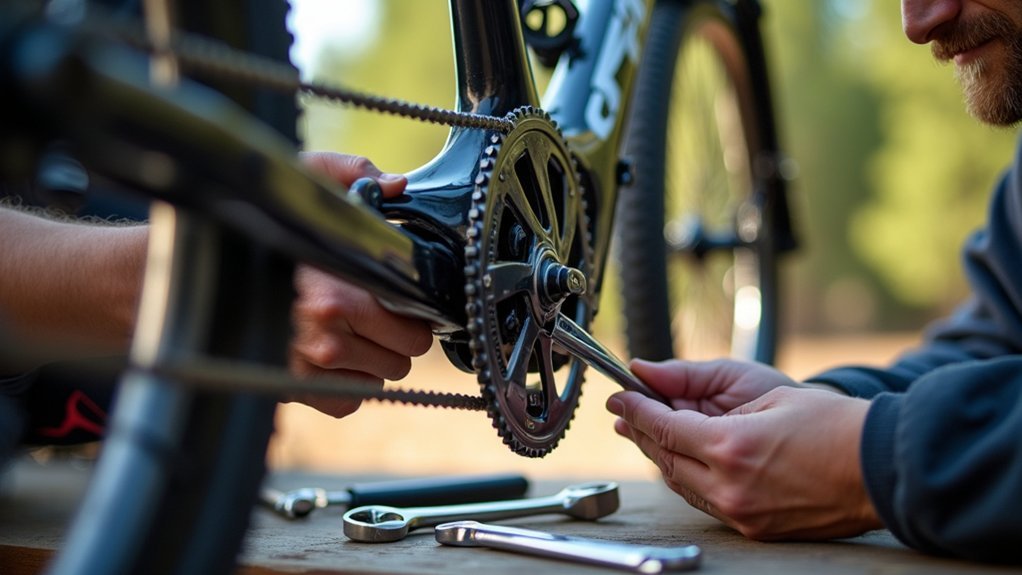



Leave a Reply